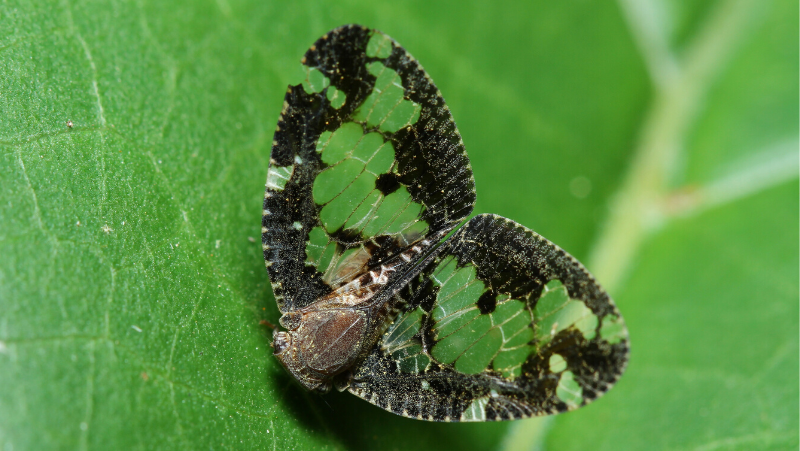Yates Account
Join now
Create a Yates account today!
Sign up to join the Yates Garden Club for monthly e-mails packed with seasonal inspiration, tips for success & exclusive promotions.
Plus if you’re a Garden Club member you can take part in the Yates Growing Community - a blog to share successes, get advice & win prizes in fun challenges along the way!

Forgot password
Enter the email address associated with your account, and we'll email you a new password.
Hemiptera / Auchenorrhyncha
Scolypopa australis

What are Passionvine Hoppers?
Passionvine hoppers (Scolypopa australis), a pest species from the Planthopper family, were accidentally introduced from Australia in the 19th Century. Both adults and juveniles suck the sap from a wide variety of plants (edible and non-edible), causing severe damage. Populations can skyrocket quickly; if left uncontrolled they will affect plant health, vigour and fruiting, with heavy infestations often causing plant death.
Description:
Adult passionvine hoppers are about 6mm long, with mottled brown wings with transparent 'windows' and brown veins, which give the wings a lacy-looking appearance. Unlike most other planthopper species, passionvine hoppers lay their wings flat while they're at rest, forming a distinctive 'jet plane' shape.
They have long, oval-shaped bodies with a pointed rear, resembling short, blunt cicadas. Three pairs of short legs are used for walking and jumping. At the front of the head is a large plate called a clypeus, which looks like a prominent 'forehead'. At the base of the 'face' are long, thin piercing and sucking mouthparts. Adults are most active from mid-summer to early winter.
Eggs are laid inside plant stems or leaf midribs, punched into plant tissue in a neat continuous row, like stitches. After each egg is inserted, pulped plant fibres are pushed in to plug the hole; these plugs can stick out and remain visible at the surface.
Eggs hatch in spring. The hatched nymphs are commonly known as “fluffy bums”, due to the tuft of fluffy white filaments attached to the tip of their tail section. These long filaments are sometimes fan-shaped, a little like a peacock’s tail. Nymphs continue to hatch and develop from early spring through to late summer.
Behaviour:
Passionvine Hoppers can be found in large groups, feeding on stem tips and leaves during daylight. When disturbed, both adults and nymphs have a habit of hopping or jumping, which sometimes produces a loud snapping or clicking noise. Adults can fly, but will usually jump first when disturbed, before flying away.
Both adults and nymphs pierce the plants vascular system (phloem) and suck out plant fluids to extract sugars. Excess water and sugars are excreted as a sticky clear substance called honeydew.
Sweet, nutritious honeydew attracts Ants, which actually protect Passionvine Hoppers from predators in exchange for honeydew! This arrangement is known as 'mutualist symbiosis'.
Excess honeydew on the leaves and stems of plants also encourages an opportunistic fungal disease called Sooty Mould to form. It's unsightly, but it can also be detrimental to plant health by interfering with photosynthesis.
Honeydew is also attractive to bees, which can be a challenge for beekeepers when bees gather honeydew formed from tutu (Coriaria) sap. Because tutu contains plant toxins, contaminated honey can be toxic to humans.

Symptoms of Passionvine Hoppers
- Clear sticky substance (honeydew) and/or a black powdery substance (Sooty Mould) on leaves, stems and trunk, possibly even nearby surfaces
- Stunted growth, reduced plant health and vigour
- Premature leaf drop or fruit drop
- Stunted and poor quality fruit
- New foliage and stems look wilted
- Dieback of sections of the plant
- Unexpected plant death
Strong evidence of passionvine hoppers:
- Adults and nymphs: usually found at the tips of leaves and stems where the most plant sugars are produced
- Shed skins (moults): at each stage of growth, nymphs moult and leave their old skins behind
- Eggs: punched into holes in a row along stems or the middle of leaves, sometimes with a pulpy tip left visible
- Insects make a loud snapping or clicking noise while jumping
Passionvine Hopper Control
Spray Yates Nature's Way Organic Citrus, Vegie & Ornamental Spray Ready to Use directly onto the insects.
- Treat at the earliest sign of infestation for fast, easy and effective control
- Prune off any leaves or stems infested with eggs.
- Wash off any parts of the plant covered in honeydew by vigorously hosing with water.

Plants Impacted
Passionvine Hoppers have a very broad host plant range; here are some of the most commonly targeted plants.
Edible plants:
- Avocado
- Cherry
- Fig
- Grape
- Kiwifruit
- Passionfruit
- Peaches
- Pumpkin
- Rhubarb
- Strawberries
- Sunflowers
- Squash
Non-edible plants:
- Citrus
- Clematis
- Coprosma
- Cordylines (Cabbage Tree)
- Dahlia
- Eucalypts (Gum trees)
- Ferns, e.g. Asplenium sp., Blechnum sp. and Ponga
- Hebes
- Hydrangea
- Manuka
- Maples
- Native NZ Flax
- Passionfruit
- Pittosporum
- Sunflowers
Weed species:
- Agapanthus
- Barberry (Berberis sp.)
- Butterfly bush (Buddleja sp.)
- Bitou bush (Chrysanthemoides monilifera subsp. rotundata)
- Fireweed (Senecio sp.)
- Japanese Honeysuckle (Lonicera japonica)
- Jasmine
- Lantana (Lantana camara)
- Privets (Ligustrum sp.)
- Purple tops (Verbena bonariensis)
- Scotch broom (Cytisus scoparius subsp. scoparius)
How to Deter Passionvine Hoppers
- Control weeds from the list above, as they may be acting as a host plant. Weeds can be controlled either by: being sprayed using various Yates Zero products (such as Yates Zero Super Concentrate Weedkiller); and/or by hand removal.
- Improving plant health will boost resilience to pest and disease attack, so ensure plants are well fed and watered regularly. Yates Dynamic Lifter Organic Plant Food releases nutrients slowly, improves the structure and moisture retention of the soil and encourages earthworms and beneficial soil micro-organisms.
- Regularly monitor plants for any signs or symptoms of Passionvine Hoppers. Small infestations, caught early, are much quicker and easier to control.















Share
Share this article on social media